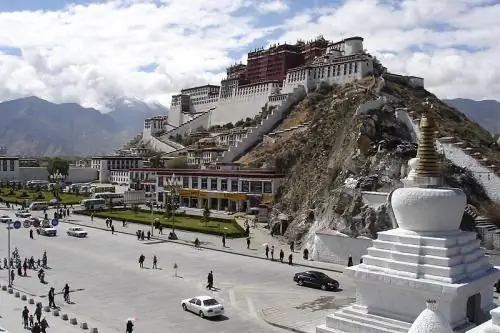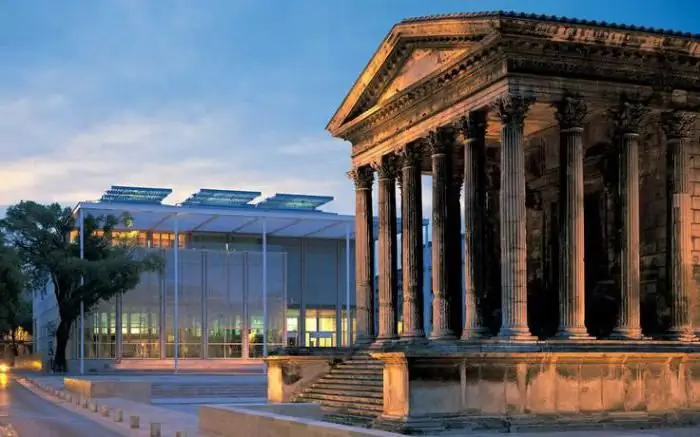- Author Harold Hamphrey [email protected].
- Public 2023-12-17 10:06.
- Last modified 2025-01-24 11:10.
Tibetan Autonomy, or Xizang, as the Chinese call it, is the third largest region in China. The historical capital of Tibet is the city of Lhasa. The autonomy is located high above sea level, on the Tibetan Plateau, the largest and highest in the world. From here originate the great rivers of India and China - the Indus, the Brahmaputra, the Salween, the Mekong, the Yangtze, the Yellow River. Specific, unusual and mysterious Tibet is a place where travelers reach a state of spiritual catharsis. He is popular, attractive, and impossible to forget.
Unique country

The tourist popularity of Tibet is based on its ancient history, religion - without knowing the basic information about this state, it is impossible to fully enjoy the beauty of its nature and architecture. Everything created by man and by higher powers gives the country its own charm.
More or less accurate data speak of the emergence of the first Tibetan state in the valley of the Yarlung River (hence the name of the ruling dynasty - Yarlung) in the III century of ourera. And starting from the 7th century, the history of Tibet appeals with specific names, numbers, and details. From that time to the present day, authentic fragments that are part of the designs of famous monasteries have been preserved. Time and wars did not spare the unique buildings of a unique culture. But restored, they attract tourists and pilgrims from all over the world. The complex, which the capital of Tibet possesses and is proud of, is under the protection of UNESCO. The peculiarity of the Tibetan culture and faith is explained not only by the inaccessibility and closeness to the outside world, but also by the territorial position - Tibet borders on such original countries as India, Nepal and China. Historically, it has long been heavily influenced by Mongolia.
Great Tibetan King

Every country throughout its existence has had a strong leader, a bright personality. The state during his reign flourished, expanded, became dominant in the region. In the 7th century AD, the wise ruler Songtsen Gampo (604-650) appeared in Tibet. He united the disparate provinces under his rule. His two wives, a Chinese and a Nepalese princess, brought Buddhism itself into the country, along with statues of Buddha given to them as dowry. The feuds with the neighbors, who became relatives, subsided for a while. Under the influence of their wives, the Chinese woman Wencheng and the Nepalese Bhrikuti, who later reincarnated as Green and White Tara, the main goddess of Buddhism, the capital of Tibet was moved to Lhasa (from Tibetan - “the abode of the gods” or “divine place”), which turned into this regionin the stronghold of Buddhism. For two statues in Lhasa, two temples were built by the ruler - Jokhang and Ramoche. Repeatedly remade, they still exist and represent the 7th century. In addition, having chosen the Red Mountain, Songtsen Gampo built a nine-story palace with 999 rooms on it, from which a cave has survived to this day, where the ruler meditated in solitude. A stream of tourists flocks here, wishing to be imbued with the wisdom of centuries and enjoy the triumph of the Spirit.
War of religions
Now the legendary Potala rises on this place. Three of these buildings are part of the complex, which is under the care of UNESCO. The capital of Tibet, Lhasa, was the stronghold of the Yarlung dynasty for another 250 years after the death of Songtsen Gampo.

But Buddhism was popular here only among a small aristocratic stratum, while the vast majority of Tibetans professed Bon Po, the faith of their ancestors. Religious differences were the main reason for the collapse of the centralized Tibetan state. However, Buddhism, on the contrary, began to gain popularity, acquiring new distinctive features. In Europe, this teaching has firmly established itself under the name of Lamaism, representing the interweaving of the philosophy of Buddhism and belief in mysterious magic. It is also called the Tibetan-Mongolian form of the Mahayana, the northern branch of Buddhism, or its late form.
The emergence of Buddhism in these territories

As a state form, Lamaism is a church country, headed bywhich stands the priest, here called the Dalai Lama. Since the 13th century, the capital of Tibet has been a stronghold of Lamaism, which has penetrated into certain regions of Mongolia, Nepal, India and China.
Buddhism in Tibet gained popularity primarily through the construction of religious monasteries, the first of them was Samye. It was erected in 770 by the efforts of Tisong Detsen, the 38th king of Tibet. After that, the then capital of Tibet lost its importance as the main city of the state. But even today this place is one of the main and popular points of the tourist route.
Rebirth after the Mongol invasion

In the 11th century, the country began to revive, but the Mongols who invaded its territory in 1239 destroyed most of the monasteries. Over time, the conquerors who settled here adopted Buddhism. And when in 1350 the monk Janchub Gy altsen (the first student of the Sakya school) began to restore them, they willingly helped him. At the end of the 14th - beginning of the 15th centuries, the Gelug (true) school began to gain popularity and increase its influence in Tibet. The monasteries of Ganden, Drepung and Sera built by her become places of pilgrimage. The ancient city of Lhasa, the capital of highland Tibet, becomes the center of a new religion, for the formation and flourishing of which the V Dalai Lama, Ngawang Lobsang Gyatso the Great (1617-1682), did a lot. Judging by the word "great", one can imagine how much he did for Tibet. On the site of the palace on the Red Mountain that burned down as a result of a lightning strike, he began to build a pearl of world architecture - the Potala Palace,which, according to the plan, was to become both the residence of the lamas and their tomb. Today, the palace is the hallmark of Tibet, its symbol.
Legendary Palace
Potala is a mountain in South India. According to Buddhist legends, Avalokiteshvara (Chenrezig) lives on it, from whom the entire Tibetan people originated. The Dalai Lama is the earthly incarnation of the Bodhisattva. And, of course, the palace was named Potala, and it became the residence of the religious rulers of Tibet until 1950, when Chinese troops occupied Tibet, and the XIV Dalai Lama was forced to emigrate to India.

New mansions began to be erected during the reign of the 5th Dalai Lama, in 1645, on the site where the 9-story castle of Songtsen Gampo once stood. Since that time, only the legendary Fa-Wana cave has been preserved in the palace, where he, the 33rd Great King of Tibet, read sacred texts. The unique building on the top of the mountain is, as it were, its continuation, reaching into the heavens. Now the two-colored handsome man has been taken under protection (several monks live in it) and is a historical and architectural monument, which serves mainly to attract tourists to Tibet. Lhasa, opened to the public only in 1980, is now a popular tourist destination.
China is doing everything to increase the flow of tourists
China pays great attention to tourism. The unique Tibetan autonomy with the capital Lhasa is a treasure that is becoming a tourist mecca. Of course, recently opened to the public, Tibet has long been a completely non-public religiouscenter. There is no such powerful infrastructure here, designed for an endless flow of visitors, as, say, in Switzerland - the oldest resort center in the world. But the lost is quickly catching up.

Already now, Lhasa, the historical capital of Tibet, has tourist complexes that meet the best world standards. There are several high-class five-star hotels, the best of the 296 that exist today in the capital of Tibet. This is Shangri-La, which is only 700 meters from the Norbulingka Palace and the Tibet Museum. It is followed by the extraordinarily beautiful St. Regis Lhasa Resort. Not inferior to them Shambhala Palace and Tashitakge Hotel.
A trip to Tibet is available to many
But these are the "best of the best" hotel complexes located in the center of the capital, within walking distance from the main attractions of Lhasa. The whole system of tourism in Tibet is thought out to the smallest detail. There are hotels with very affordable prices, as well as with a flexible system of benefits, such as food stamps, free cancellation, discounts on airline tickets and much more. The vast majority of hotels have very high ratings and good reviews. Now Lhasa is called “city of hotels”. But it is also a city of unique sights. These include the Potala Palace and Jokhang Temple, Berkhor Street and the Drepung, Sera, Ganden, Trugo and Tsanggu Nunneries. A list of major attractions would not be complete without Pabongka Abode and the tombs of early Tibetan kings.






